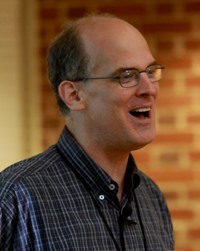The Meaning of Maxwell's Equations, Part 3: Gauss' B Law
Date: 2011-10-08 Time: 07:00 - 09:00 US/Pacific (1 decade 3 years ago)
America/Los Angeles: 2011-10-08 07:00 (DST)
America/New York: 2011-10-08 10:00 (DST)
America/Sao Paulo: 2011-10-08 11:00
Europe/London: 2011-10-08 14:00
Asia/Colombo: 2011-10-08 19:30
Australia/Sydney: 2011-10-09 01:00 (DST)
Where: Online Video Conference
This video conference used Fuzemeeting.
The meeting can be replayed by clicking this link:
https://www.fuzemeeting.com/replay_meeting/fccff073/2159565
Description
This third in a four-part series on the Meaning of Maxwell's Equations discusses the "other" Gauss Law, or the non-divergence of a magnetic field. Physically div B = 0 means that ultimately every motion must constitute part of a circuit. In review, the Gauss D Law (Part 1) expresses the principle that matter fundamentally repels, diverges or spreads, while Ampere's Law (Part 2) that motion is the root cause of all attraction, including gravity. Now the simplest, yet most profound and misunderstood of the four laws, Gauss B, expresses the principle that the motion which binds matter together within a finite object must circulate. And the implications of this simple observation are breathtakingly foundational. To begin, though the law applies to the infinitesimal, circuits are inherently group-like and finite, part of a system. Indeed particles exist precisely because circuits are fundamental. But more, any closed path always has a center or vortex, and thus every motion can be associated with some rotation group, and thence some vortex center. Even the interactions between particles create various topological types of vortex or node points, so that all quantum events can ultimately be described via the interactions between rotation groups, and the behavior of a complex system can be fully determined by an analysis of the critical node points alone. Yes, the Gauss B Law is the Law of the quantum, governs several otherwise mysterious quantum conservation laws, and moreover provides the link to unify electrodynamics (which operates on the continuum) with quantum mechanics and thermodynamics (which are fundamentally statistical). Recently Ruggero Santilli and others have connected irreversibility with anti-Hermitian complex algebras, while it has been well known since Euler that complex algebras provide the best means of describing rotations. Therefore, it should come as no surprise that irreversibility arises from the interaction of rotation groups, as evidenced by turbulence from a combination of eddy currents or shears within a deformable body. This also accounts for Mahmoud Melehy's "Principle of Detailed Balancing", which holds that non-conserved quantities at the macro-scale are in fact conserved at the micro-scale, and shockingly that entropy itself in conserved at the infinitesimal level. In fact, this law provides profound new insights to the thermodynamic kT energy, and gives physical meaning to Boltzmann's constant k. As final thoughts, Huygen?s ?odd sympathy? illustrates the connection between synchronized rotations and equilibrium, and Newton's 3rd Law itself extended to the continuum essentially restates the closed circuit principle.



